FRED VAN LENTE gets back in the ring!
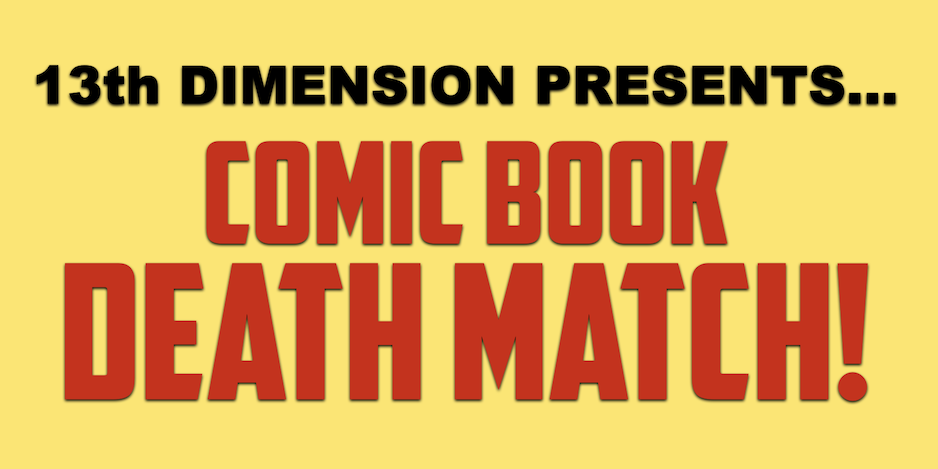
In a lot of respects, this is recurring 13th Dimension columnist Fred Van Lente’s gutsiest COMIC BOOK DEATH MATCH — pitting Marvel’s cult-fave 1980s maxiseries Squadron Supreme against what’s widely considered the greatest superhero graphic novel of all time, DC’s Watchmen.
But it’s all about the details, isn’t it? So sit back and dig this exploration of two surprisingly similar, yet substantially different, comics classics.
Who wins the big brawl? Read on.
—
By FRED VAN LENTE
Hey there! For this latest installment of COMIC BOOK DEATH MATCH, we are simultaneously reading two comics often mentioned in the same breath: Watchmen by Alan Moore and Dave Gibbons, and Squadron Supreme by Mark Gruenwald and a bunch of artists, most notably Paul Ryan. Both are dark, self-contained mid-1980s 12-issue maxi-series that challenge the suppositions of the superhero genre; and, not coincidentally, their main characters are analogues for another company’s heroes.
Rando humans given superpowers by the Grandmaster to fight the Avengers in Issue #70 of that mag by Roy Thomas and Sal Buscema, the Squadron Sinister were obvious stand-ins for Superman (Hyperion), Batman (Nighthawk), Flash (Whizzer), and Green Lantern (Dr. Spectrum).
But of course this was far too clean-cut an explanation for Thomas, he of the Grand Unifying Geek, who retconned his own work in Avengers #85. There we learn that in addition to all his other flaws, Grandmaster is a plagiarist: He ripped off the idea for his Sinisters from the Squadron Supreme, a sort of League of the greatest heroes of an alternate reality, where they fight for Justice (get it, get it).
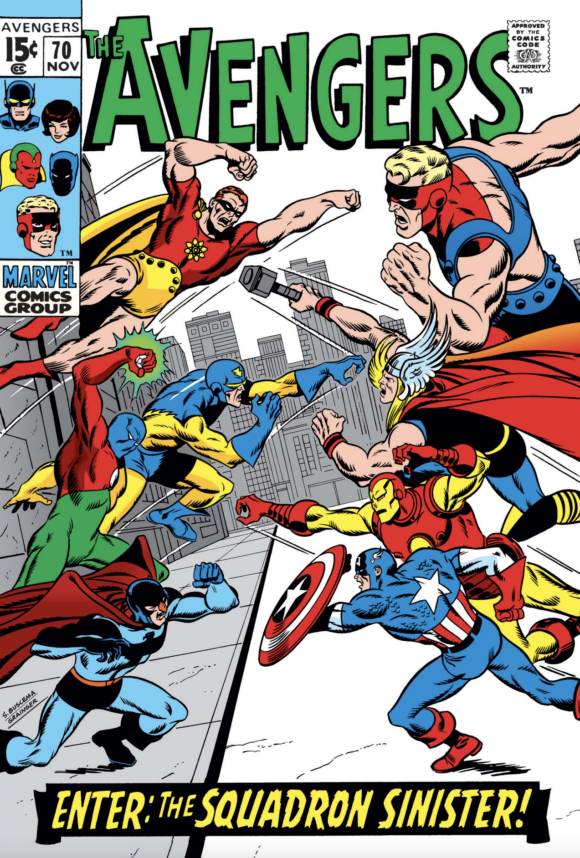
Likewise, the main characters of Watchmen are all stand-ins for heroes created for notoriously shady publisher Charlton that were acquired in the 1980s by DC: Captain Atom (Dr. Manhattan), the Question (Rorschach), Peter Cannon: Thunderbolt (Ozymandias), Blue Beetle (Nite Owl), Nightshade (Silk Spectre—sort of) and Peacemaker (the Comedian).
Alan Moore crafted a story that was basically “Who Killed Peacemaker?” but DC editor-in-chief Dick Giordano, who had gotten his start at Charlton, immediately saw that Moore’s plans would render most of those heroes useless for further exploitation, and asked Moore to come up with his own characters instead.
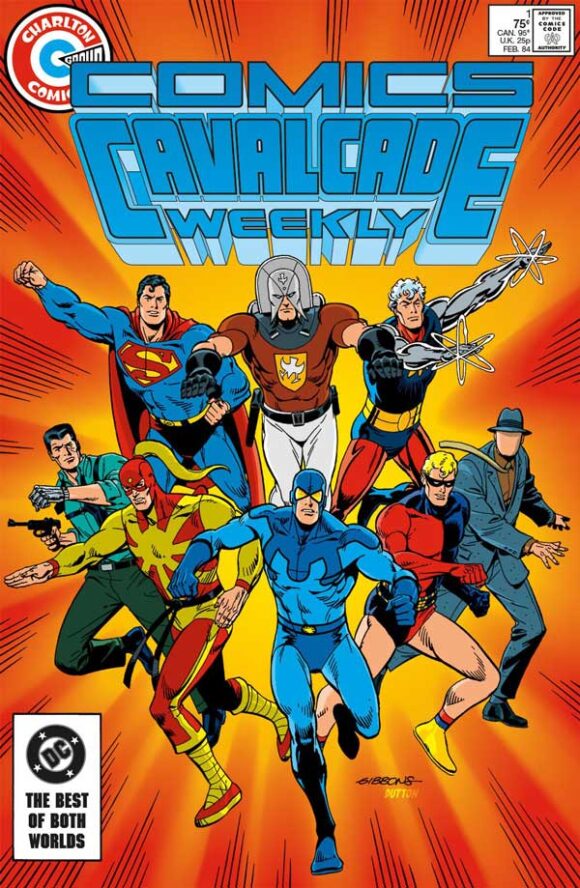
Never published DC series. Art by Dave Gibbons. Modern colors by Scott Dutton.
All the Charlton headliners would in fact go on to become fairly significant players in the DC Universe in one way or another (Peacemaker, in fact, is the first-ever DCEU original TV series), except for Peter Cannon: Thunderbolt, whose rights would be reclaimed by his creator, Pete Morisi, and maaaay get a reboot verrrrry soon written by someone you may be familiar with, cough cough.
Even though they are in fact good guys, the Squadron Supreme gets mind-zapped into fighting the Marvel Universe’s heroes a lot. Under the influence of a Serpent Crown-entranced US President Nelson Rockefeller (yes, really), they go after the Assemblers in an epic arc beginning in Avengers #141, the first ish of a wet-behind-the-ears kid named George Perez, with an amazing Gil Kane cover that graced many a kid’s Trapper Keeper (including mine).
Presidents of the Squadron’s USA have some rough luck. Batman—uh, Nighthawk gets elected after Rockefeller and then is almost immediately ensorcelled by back-bencher Fantastic Four villain the Overmind. The USA becomes a fascist state that then takes over the whole world. Hyperion manages to recruit the Marvel Universe’s Defenders to liberate Marvel’s Earth-S, but the ordeal leaves global infrastructure in shambles.
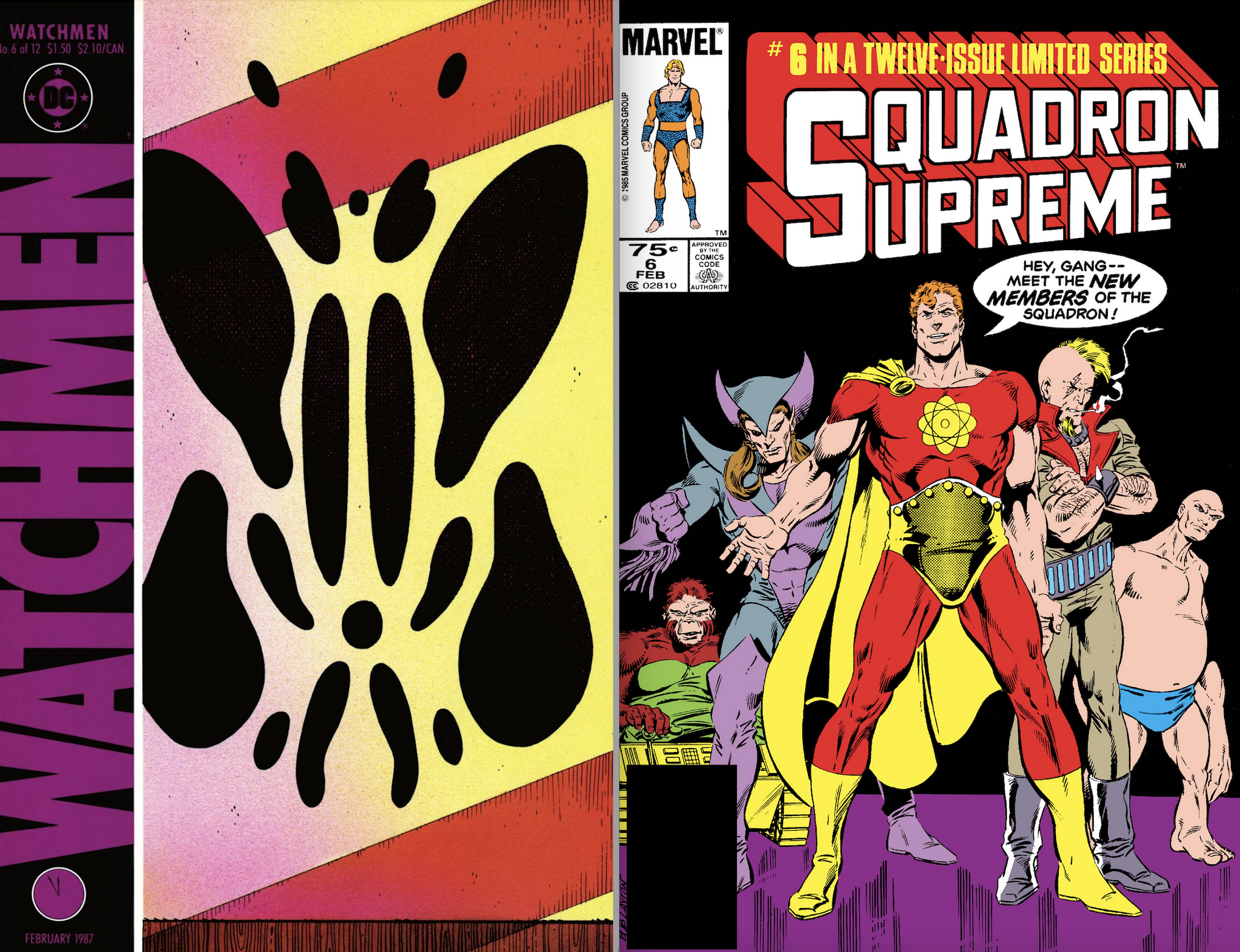
Of course, the USA of Watchmen is a mess, too. Having repealed term limits, Richard Nixon (who in real life was succeeded by Gerald Ford, who then picked the real Nelson Rockefeller to be his veep) is basically president-for-life, thanks, in no small part, to a certain “superhero” killing Woodward and Bernstein. There are massive tensions with the Soviet Union, superheroes have been outlawed, leaving those remaining masks to go underground, legally (Comedian) and otherwise (Rorschach). One superhero, Dr. Manhattan, has used his nuclear powers to create technologies previously dreamed of in science fiction.
Squadron Supreme #1 came out first, in May 1985, according to our pals at Mike’s Amazing World, and Watchmen #1 wouldn’t come along until the following year, in June, so I can’t do my usual schtick of reading titles month by month; and that’s not even really appropriate here, as these are both self-contained novels, not ongoing series. So I’ll go chapter by chapter, and see what interesting things we discover by comparing and contrasting them at each step.
Hope you have as much fun reading this as I did writing it, and inspires you to give a second look at these books yourselves.
But enough prelude! Deconstructionist superhero sagas of the Eighties…
FIGHT!
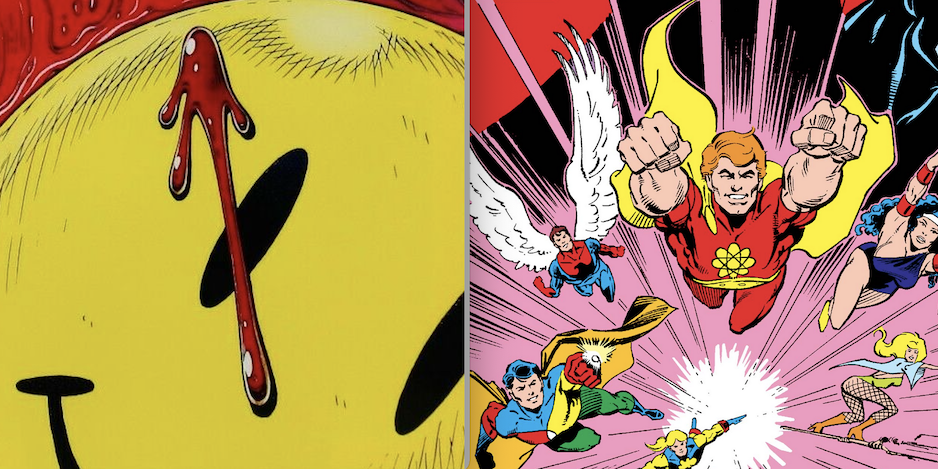
—
Squadron Supreme #1: “The Utopia Principle”

In this double-sized first issue, Gruenwald and West Coast Avengers MVP Bob Hall deftly introduce a dozen or so Squadroners and their backgrounds in little vignettes. I love the DC-style fictitious city names on Earth-S, which also have fictitious states (“Atomic City, Herculanea”… “Cosmopolis, New Troy”… etc.) After trying to help his shattered world through conventional superheroics, Hyperion realizes the futility of the Squadron’s efforts and proposes, instead, that since they broke the world in the first place, the heroes have a responsibility to rebuild it better than it was before… but this will require them to take over the United States government.
Unsurprisingly, the person who most protests this benign super-dictatorship is the current US president, Batma—er, Nighthawk. He fashions a bullet from Krypto—er, argonite—which happens over a year before an older Batman gets the same basic idea in Dark Knight Returns. When he resigns as president and turns the country over to the Squadron Supreme, though, he can’t bring himself to shoot his best friend Hyperion in the back.
This is a clunky, wordy comic with rushed art from Hall (the inker isn’t doing him a lot of favors, either), but there’s something very cool in a story ending with a superhero choosing not to do violence (in this case, cold-blooded political murder, but still). A great start for the series.
—
Watchmen #1: “At Midnight, All the Agents…”
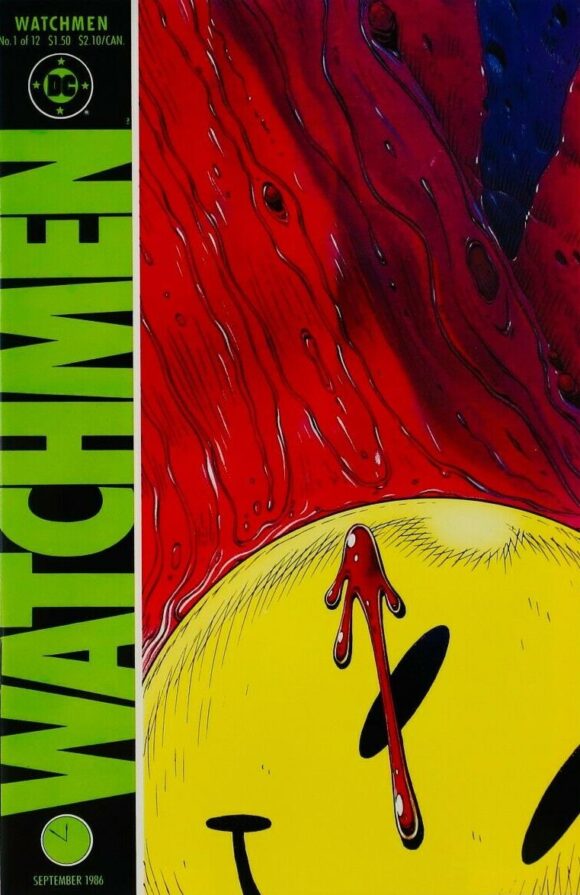
While Squadron Supreme tells an unconventional superhero story in a very conventional way, Watchmen hits us with formalistic brilliance at the jump: the cover that doubles as the first panel, the nine panel grid, the Bob Dylan quote title (“Desolation Row”), the POV of Rorschach’s unhinged right-wing Son-of-Sam-meets-Holden-Caulfield journal.
I’m not the only person who’s disturbed that the problematic Rorschach has long been Watchmen’s most popular character. In #1 Moore and Gibbons certainly beat us over the head with how unpleasant this guy is: He smells bad, he eats cold beans out of a can like a hobo, he breaks a rando’s fingers in a bar for making for fun of him, and the worst thing he can think to call anyone is “prostitute,” which he uses to refer to, in this issue alone, politicians, his landlady, Ozymandias, and Silk Spectre I. Given what we later learn about Rorschach’s parentage this is obviously meant to be Freudian, though it’s more sledgehammer than slip.
That said, Rorschach is to Watchmen what George Washington is to the USA: The Indispensable Man. It’s Rorschach who just decides, on his own, to investigate the murder of rich stranger (to him) Edward Blake; it’s Rorschach who spends an entire page checking to see if a closet has a false compartment where Blake stores all his Comedian gear; it’s Rorschach who, on the basis of this one murder alone, declares there’s a “mask killer” and sets out to warn every one of the other major characters.
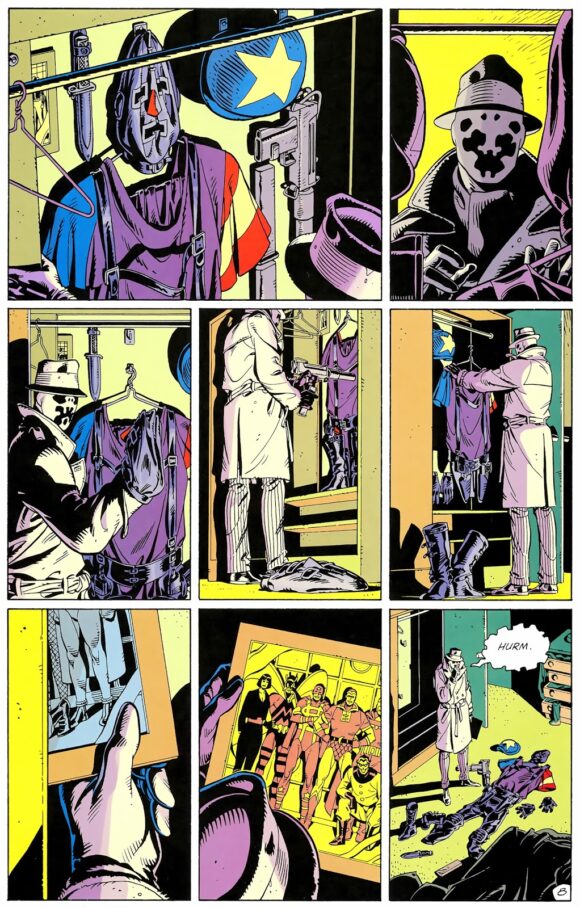
It seems a little contrived. Or… is Moore saying that you can’t separate the misogyny, racism, sadism, and every other negative “ism” wrapped up in most superhero mythos from the genre itself, much in the same way Rorschach can’t be separated from the plot here?
I’m not saying he is saying that… but then I’m not saying he isn’t saying that, either.
Moore’s skill with high concepts and careful plotting often overshadows his top-notch characterization, but that remains the most continuously impressive thing about Watchmen for me: the way he contrasts Dr. Manhattan’s godlike inscrutability with Silk Spectre II’s take-no-BS abrasiveness, which, when she goes out to dinner with Nite Owl II, contrasts well against his wounded fanboy nostalgia. And, of course, Gibbons’ skill at creating a fully-realized alternate universe within a single issue is exceptional.
Overall, the story and art in Watchmen #1 is better than Squadron Supreme #1, but it is all set-up, while Gruenwald and Hall’s inaugural effort has a nice little contained story of whether or not Batman should kill Superman (Zack Snyder, take note) and I’m judging these comics on an issue by issue basis, so:
WINNER: SQUADRON SUPREME
—
In the interests of brevity, I won’t look at every issue of these series, and besides I cover the salient points of both #2s later, so I am going to skip ahead to:
Squadron Supreme #3: “Showdown”
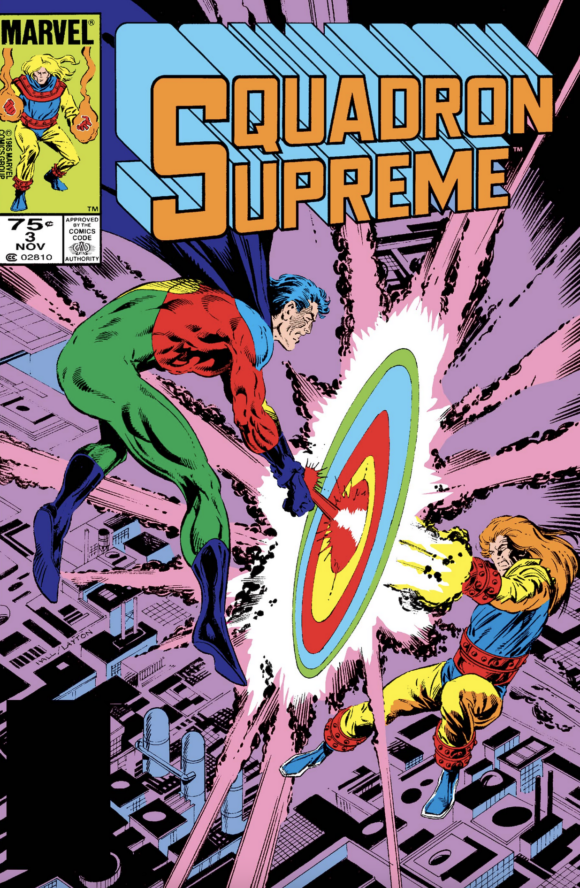
Sure, the Squadron may be abolishing American democracy, but you’ve got to hand it to them: They’re trying to make good on their “solve everything” promise. School shootings? No problem! Wonder Woman (er, Princess Power) cuts an anti-Second Amendment PSA saying, basically, maybe you don’t need guns, now that superheroes are in charge? Faster than you can cry, “It’s in the Constitution!!”, rednecks start raiding gun factories to grab as many boomsticks as they can. Gruenwald and Hall do a great job greasing the slippery slope, here.
You know, I hear this whole “cancer” thing is a big problem, too. Firestorm (Nuke) has vanished, and when Dr. Spectrum tracks him down, he learns to his horror that Nuke’s radiation level has increased, giving his parents lethal cancer. Nuke swears to kill Atom (Tom Thumb), the Squadron’s resident super-genius, for failing to cure them, and in trying to stop him, Spectrum kills Nuke by accident, plunging the hero into deep despair.
Gruenwald and Hall’s willingness to knock off major characters this early in the series must have come across as a shock in 1985; though still relatively early in his storied comics scripting career, Gruenwald sometimes writes dialogue like he’s an alien from outer space (when Dr. Spectrum asks Nuke’s kid brother if this is the cemetery where his recently-dead parents are buried, the kid says “I’m not sure since I was only there twice and it was daylight both times.” Huh?) but this is a solid entry in the series.
—
Watchmen #3: “The Judge of All the Earth”
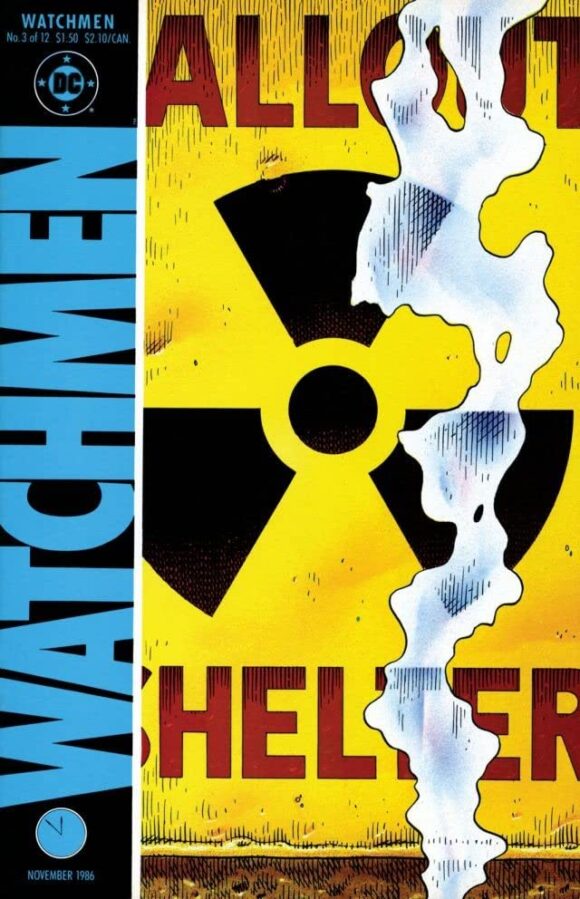
Wait a minute, did I just say nuclear superheroes giving their loved ones fatal cancer?!? And in the third issue of their maxi-series, no less? Dr. Manhattan melts down (uh, not literally) in a press conference when he learns that his “Girl Friend,” Janey Slater and “Pal,” Wally Weaver, have died of radiation exposure, and he decides to fuck off to Mars, driving his current girlfriend further into the arms of Nite Owl II.
This makes the coincidences that mounted during our X-Men/Doom Patrol Deathmatch look like “Ancient Aliens.” That said, I think this has less to do with Alan Moore ripping off the previous year’s Squadron Supreme than the prevalence of nuclear-powered superheroes and the fact you or I would be afraid of standing next to such a person without wearing lead underpants. (In fact, the following year, Nuke and Dr. Manhattan’s respective inspirations, Firestorm and Captain Atom, would be throwing down in the comics racks after the former gave himself cancer.)
I completely forgot, until this reread, that the DC Universe’s heroes existed as fictional characters in the world of Watchmen—Nite Owl I cites Action Comics #1 as an inspiration in his autobiography—but the prevalence of actual supers caused them to fall into obscurity, replaced by other genres of comics, like pirates.
Speaking as someone who got the Warner Books softcover of Watchmen for Christmas (per my request) and read it all in one sitting on December 25, 1988, I have gone from being mildly annoyed at its “Tales from the Black Freighter” comic-within-a-comic as a teenager to, over the course of several re-reads, utterly loathing it as overwritten padding. It starts to be inflicted on us here, and for that reason alone:
WINNER: SQUADRON SUPREME
—
Squadron Supreme #4: “Change of Heart”
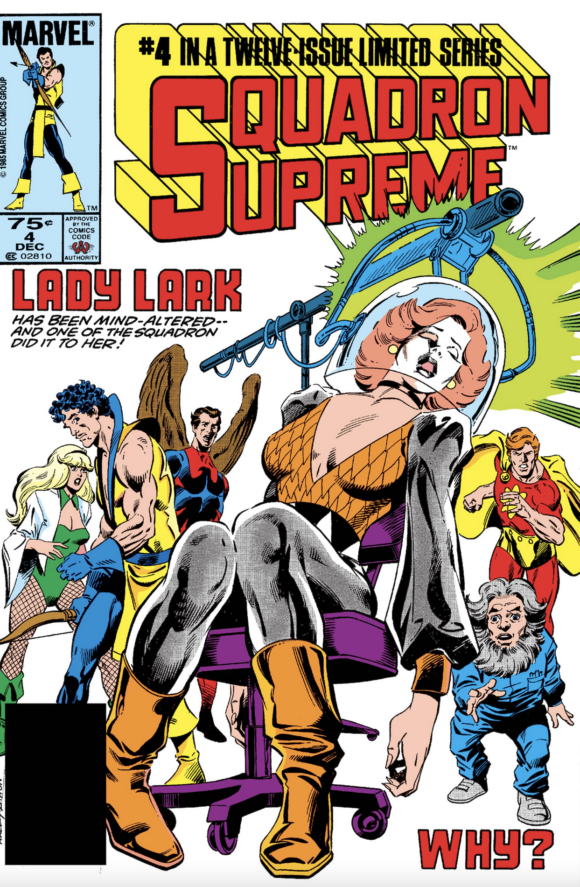
Alan Moore has often said that Charlton’s Nightshade (who would go on to be an MVP in John Ostrander’s Suicide Squad) was less of an inspiration for Watchmen’s Silk Spectre than the busty focus of Frederic Wertham’s ire, Phantom Lady, and, perhaps more importantly, Black Canary, who in addition to being created by Carmine Infantino as “[his] fantasy of a good-looking girl,” was one of the first “legacy” heroes in regular DC Continuity, a crossover from Earth-Two who inherited the mantle from her mother, just like Laurie Jupiter.
I bring this up here to note another, more uncomfortable similarity between Watchmen and Squadron Supreme: both have Black Canary analogues, both of whom are sexually violated by a male teammate.
In Watchmen #2, Silk Spectre I is raped by the Comedian in Minutemen headquarters. In this issue, the Squadron’s Black Canary (Lady Lark) rejects Green Arrow’s (Golden Archer) marriage proposal because she wants to focus on her singing career. Unfortunately for her, Tom Thumb has invented a behavior-modification device to cure criminals of their, uh, Crime Thoughts in exchange for reduced sentences. Golden Archer sneaks into the barracks late at night and zaps Lady Lark with the device, giving her the change of heart of the title.
Look, you don’t need to be Andrea Dworkin to figure out what’s going on here: Preadolescent fans who grew up fantasizing about Black Canary’s fishnets are both fulfilling and condemning those desires as adult creators by punishing their inspiration—and forcing the reader to watch. It’s the male gaze expressing well-earned contempt for itself, in Watchmen through literal violence, in Squadron through sci-fi hoodoo.
These crimes reverberate with appropriate trauma through both novels. Sally Jupiter’s violation has a huge impact on her daughter’s story. Ultimately, Golden Archer’s crime is discovered and he is expelled from the Squadron, and ironically, Lady Lark, who can’t not love him, quits along with him. Aquaman (Amphibian), who never liked the “B-Mods” to begin with, smashes the machines and returns to the sea, washing his hands of the Squadron for good.
Gruenwald and Hall do a great job of laying down good-intentioned paving stones like a highway crew to hell.
—
Watchmen #4: “Watchmaker”
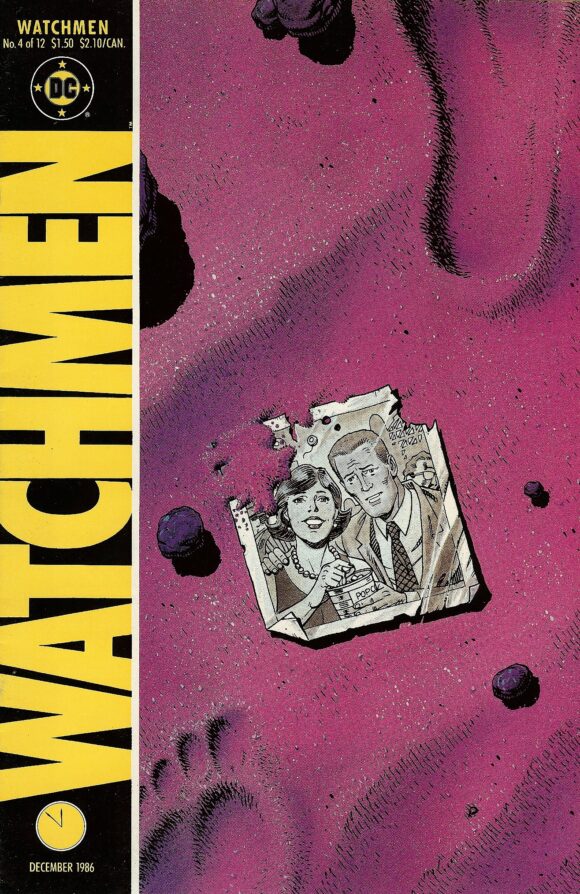
If you think about it, Watchmen’s chapter structure is as formalized as its panel grid: In its first half, every odd issue propels the plot forward, while every even issue is a mostly self-contained origin story of one of the main characters. In #2 we get the Comedian’s backstory, #6 is a deep-dive into Rorschach, and Dr. Manhattan gives us his life story here.
I don’t have a lot of earth-shatteringly original things to say about this comic, one of the best single issues ever. It takes the series from being simply extremely good to sublime, as it shows off how carefully Moore and Gibbons have planned out this alternate history and all the interlocking plotlines—I can’t be the first person to think that its title refers as much to its authors as its headliners—and, given that the whole thing is from the previously inscrutable Dr. Manhattan’s POV, its many unforgettable lines make it one of the most memed comics of all time.
This comic arrived on the racks in September 1986, 48 and a half years after the first appearance of Superman. Though many, many superhero comics had been created in that span, this is the first one that truly gave readers some insight into what it must be like to be a superman. For that reason, it’s going to be better than most any other comic you put it up against it.
WINNER: WATCHMEN
—
Squadron Supreme #5: “Turnabout”
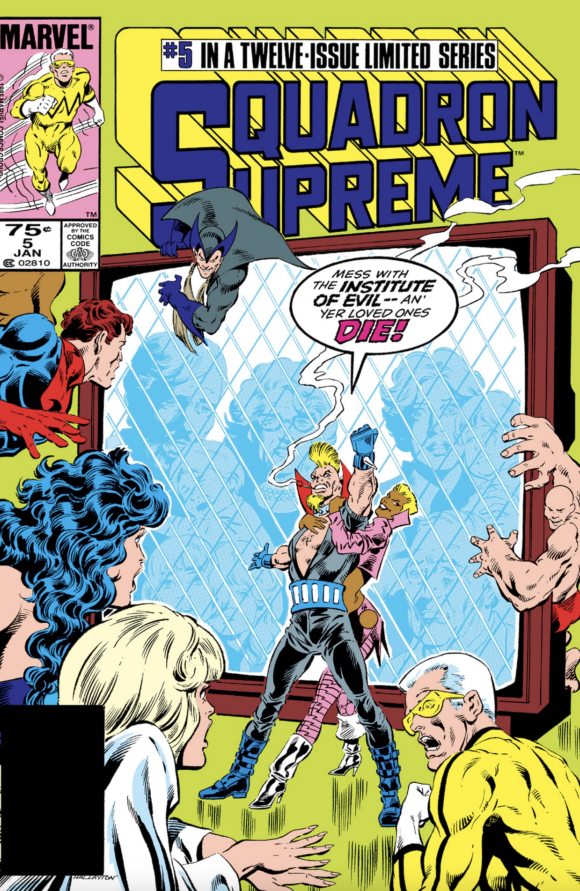
Each of our novels, as they reach the halfway mark, use their fifth installments to check in on the supervillains of their respective worlds. The Institute of Evil, archenemies of the Squadron, are none too thrilled with the heroes’ brainwash-everybody-into-being-good plan, kidnap Golden Archer and torture him into revealing the Squadron’s secret cave headquarters. (Just like the JLA, the Squadron graduated from a cave to a satellite, but that fell out of the sky in #1.)
Using what they learned about the Squadron members’ secret identities, they kidnap the heroes’ loved ones and tell them to kiss their spouses and kids goodbye if they don’t get subjected to their own behavior-modification machines—except, Tom Thumb tweaked the machines so they won’t work on the Squadron, having (correctly) suspected Golden Archer of using it to no good end last issue. And when the Squadron defeats the Institute, they immediately brainwash them into joining their ranks! Take that, Identity Crisis.
Oddly, few of the Institute of Evil appear to be direct analogues of DC Universe villains, which seems like a missed opportunity. Or did a lot of these go over my head?
—
Watchmen #5: “Fearful Symmetry”
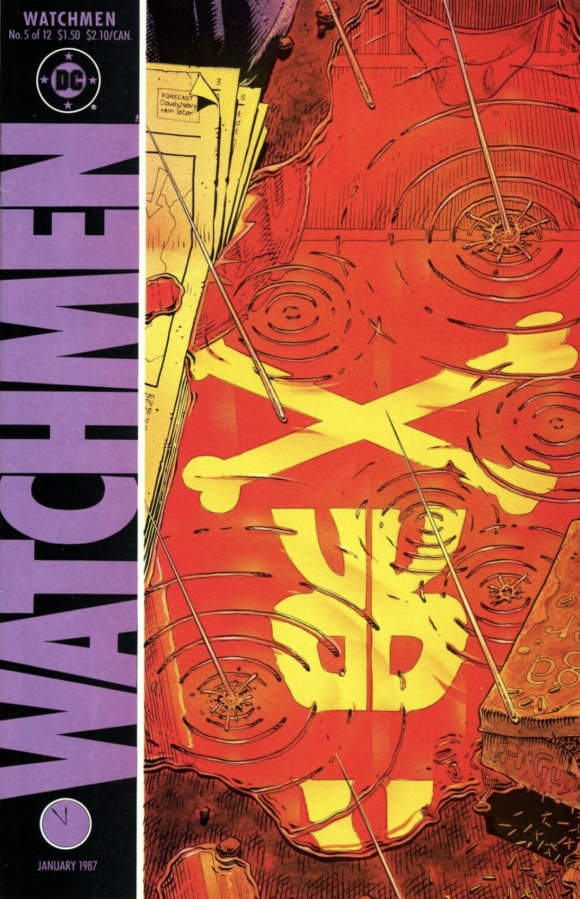
Likewise, over in Earth-W (a term I just made up), retired, sickly villain Moloch takes center stage as Rorschach is convinced he knows more about this “mask killer” business than he’s letting on. Also, someone tries to assassinate the world’s smartest man, and the now-homeless Laurie moves in with the currently friend-zoned Dan.
This would be a fairly pedestrian move-the-ball-down-the-field chapter (by Watchmen standards) were it not for the bravura formalist performance foreshadowed by the title: This issue is a palindrome of scenes, the first half a mirror of the second, with the double-page attempted murder in the middle: Six pages of Rorschach in Moloch’s apartment, a page of the cops, two pages of the kid reading “Black Freighter,” a page of Dan and Laurie, one of Rorschach solo, one more “Freighter,” and then after the attack on Adrian Veidt, the whole thing scrolls back out again in the opposite direction, with Rorschach getting captured by the cops at Moloch’s in the end.
As someone who makes these things for a living, Moore and Gibbons’ commitment to this schtick—whole panels are mirrored precisely—fills me with equal parts awe and horror. I’m not sure it actually adds anything to the story itself, but man, it is cool.
WINNER: WATCHMEN
—
I’m going to skip #6 of both titles in the interest of space, pausing only to note that while the historical inspiration for Rorschach’s origin, the murder of Kitty Genovese, is real, what actually turned him to costumed vigilantism was dozens of her neighbors refusing to help her and/or just passively watching her die; and that turns out to have been an urban legend manufactured by The New York Times that they didn’t bother to correct until 2016. Durn you, mainstream media!
Squadron Supreme #7: “Love and Death”
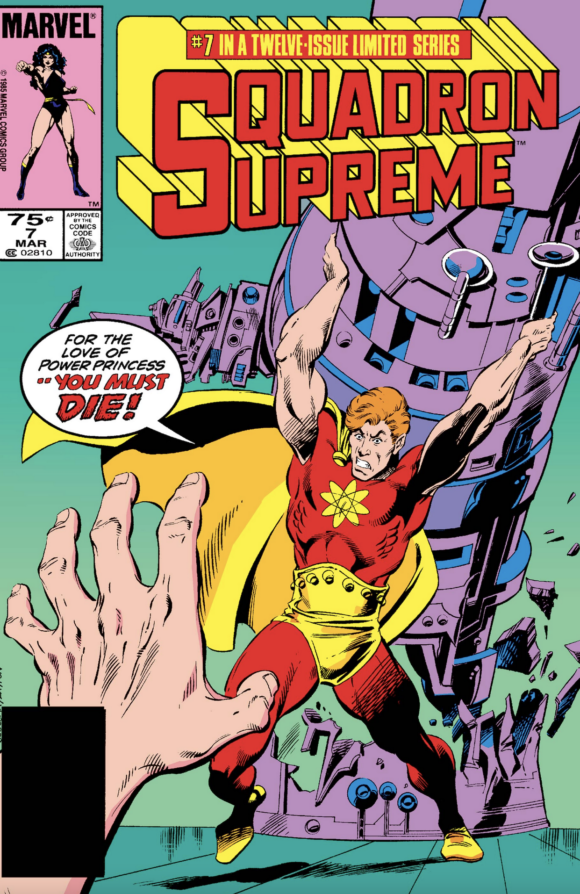
Squadron Sinister co-creator John Buscema inexplicably guest-pencils this issue. Remember above where we laid out that Grandmaster empowered a quartet of regular Joes into evil versions of the Squadron to fight the Avengers? Well, here, Master Menace, Hyperion’s archenemy, who’s kind of a cross between Lex Luthor and original-suit Iron Man, plucks the bad 616 Hyperion out of the interdimensional ether to replace his good Earth-S counterpart.
616-Hyperion falls in love with Princess Power, and when her husband Steve Trevor Howard Shelton, whom she met during World War II, dies of old age and doesn’t come back to possess an innocent rando’s body thanks to a wishstone, Lie-perion (see what I did there) realizes he can’t risk losing her by going through with Master Menace’s plan. So he pounds on the villain so badly Menace flees to another dimension, and two panels after Princess Power’s husband’s funeral, they’re swapping spit on the beach. Boy’s got game!
—
Watchmen #7: “Brother to Dragons”
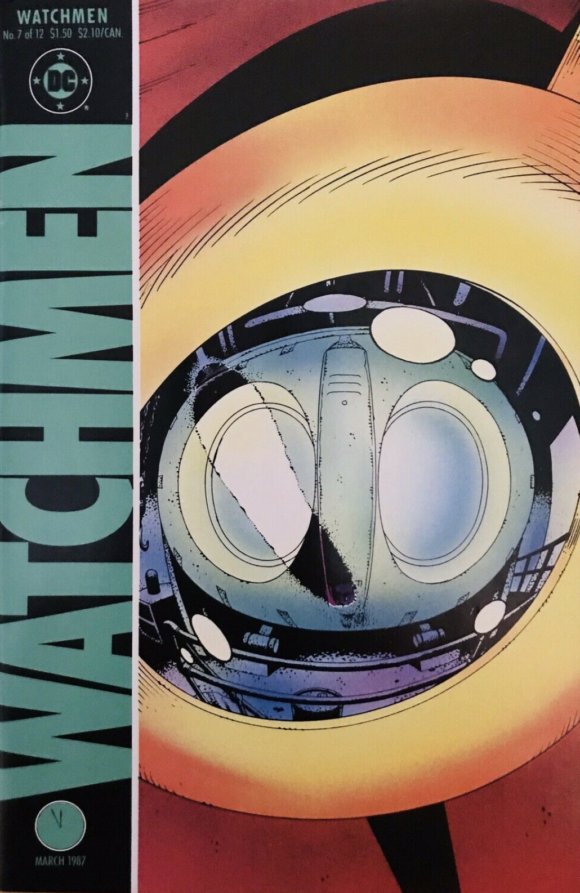
“Love and Death” could just as easily be the title of this issue, too; instead we get a quote from the Book of Job that mentions owls. (Sixteen-year-old me thought Moore’s epigrams were the height of sophistication; now they just seem jarringly on-the-nose.)
New roomies Nite Owl II and Silk Spectre II hang out, chat, try to have sex, fail, then decide to dust off the ol’ costumes and take them out for a spin, and then screw successfully in a floating owl ship. It’s a very sweet, stirring two-person one-act play, with a big-ass tenement fire in the middle of it.
Hey, here’s a thing that happened to me: I got invited to a screening of Zack Snyder’s Watchmen (2009) in Manhattan and happened to be sitting in front of Paul Levitz. I whispered to my wife to not say anything bad about the movie because the head of DC was sitting behind us, then immediately kicked the soda resting at my feet over, covering my and (perhaps) Paul’s shoes with Diet Coke.
Later I had to bite through my tongue so as to obey my own dictum because Snyder’s depiction of the sex scene from this issue, with “Hallelujah” blaring on the soundtrack, remains to this day one of the most cringe-inducing things I’ve ever seen committed to a movie screen.
Am I going to hold that against Moore & Gibbons? Hell, no:
WINNER: WATCHMEN
—
Squadron Supreme #8: “The Clash”
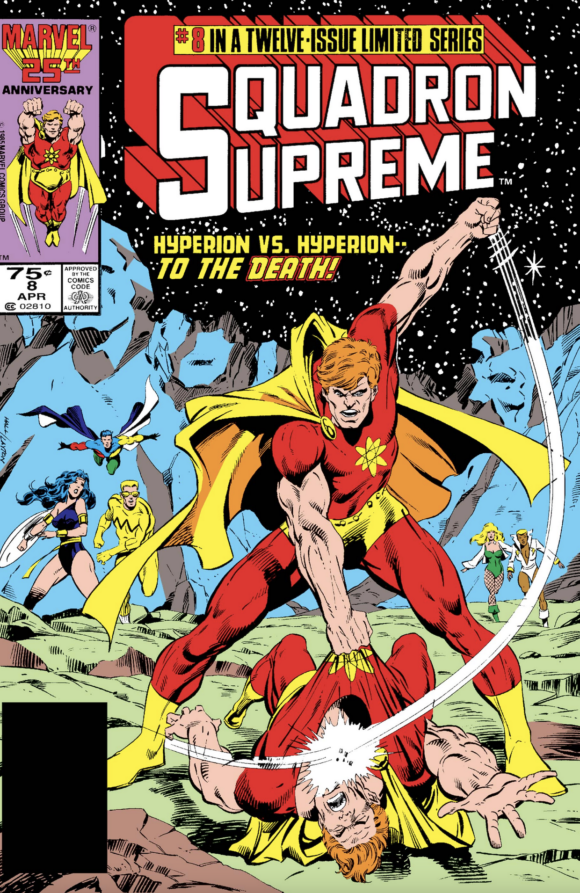
Lie-perion doesn’t enjoy his perfect, stolen life for long, for Master Menace and the real Hyperion encounter each other in interdimensional limbo and forge a very, very brief alliance to get back to Earth-S.
In a nice touch, the two Men of Adamantium (see what I did there) duke it out on “President Mountain,” which depicts Washington, Ben Franklin, JFK and Lincoln. (At this point Bob Hall has been replaced by Gruenwald’s future DP7 collaborator, Paul Ryan, and it’s a net positive.) Hyperion gets so mad that he basically melts the imposter with an atomic blast so powerful he blinds himself, too.
Weirdly, Gruenwald has Lie-perion declare he killed the Princess’s husband so they could be together, which even a close reading of the previous issue does not bear out. Why the retcon? So we feel less bad that he gets straight-up murdered by Hyperion, maybe? (Really smacks of Jim Shooter demanding that Dark Phoenix had to die so she wouldn’t get away with global genocide.) Even still, it’s grim as hell!
—
Watchmen #8: “Old Ghosts”
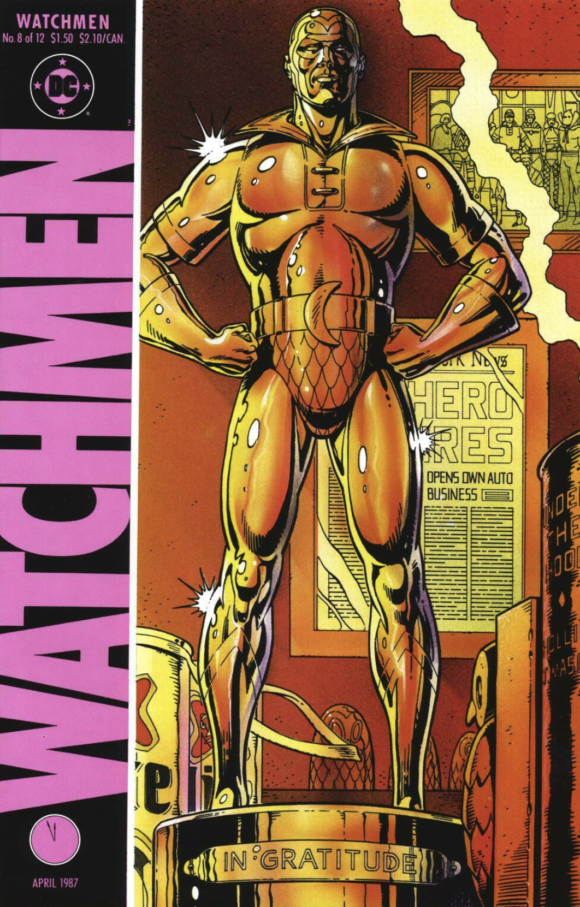
The centerpiece of this issue is Dan and Laurie’s thrilling breakout of Rorschach from prison. Yes, literary this and deconstruction that, but the bottom line is Alan Moore can script a crackerjack action sequence when he wants to. You don’t really associate Watchmen with rah-rah, fist-pumping moments, but the return of the heroes that this and #7 represent still gives me goosebumps decades later.
Another noteworthy aspect of Earth-W is how virulently polarized the media is, 2021-style: The right-wing New Frontiersman, beloved by Rorschach, demands a return to the superheroes, and is continuously being denounced as fascist by the squishily liberal Nova Express. Sadly Moore and Gibbons are on to something: If anything in our world closely resembles something from Watchmen, it’s this. (The pro-superhero political cartoon in the backmatter issue of Frontiersman we get appears to have inspired The Onion’s whole rightwing-lunatic cartoonist schtick!)
This is a strange issue. There’s a blizzard of verbiage, and way too much “Black Freighter,” punctuated by a costume-less Rorschach’s bloody murders of various inmates. I’d almost give this one to the slugfest and tragic ending of Squadron Supreme, but that dumb retcon ending really annoys me. So:
WINNER: DRAW
—
Squadron Supreme #9: “Borrowed Time!”
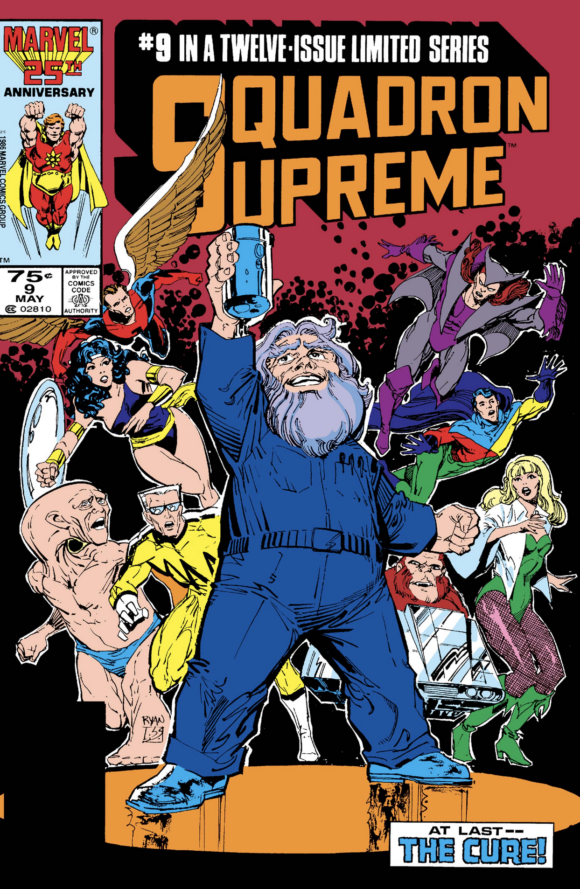
The ninth chapters of our novels both heavily revisit events from their second. In Squadron Supreme #2, resident super-genius Tom Thumb traveled to the far future to persuade 40th century tyrant Scarlet Centurion to give him the cure to cancer to save Nuke’s parents. (Gruenwald breaks from the tradition of DC analogues, as this Squadron arch-nemesis is yet another Kang incarnation.)
The Centurion wanted Thumb to murder Hyperion in exchange (on everyone’s to-do list in this series), and he refused. However, reformed Institute of Evil members convince goody-two-shoes Tom, having contracted cancer himself from his Nuke studies, to go to the future and just steal the damn cure.
In a clever twist, the Time Heist goes off well enough for Tom and Lamprey (Parasite?), the Institute’s energy vampire, who return to Earth-S with the serum, only to discover that it doesn’t work on 20th century people’s less refined genes.
Sadly, whatever effectiveness this story might have had is ruined by the final panel, which is an all-caps editorial announcement that Tom died the next week at his desk of cancer.
What the hell is this “Poochie died on the way back to his home planet” crap?! The opening splash of the next issue is Tom lying in his coffin at his funeral, guys. I think we could’ve figured out what happened from context clues. Two issues in a row have been ruined by last-minute “The Readers Are Stupid Babies, Over-Explain Everything” shenanigans endemic in Shooter-era Marvel.
—
Watchmen #9: “The Darkness of Mere Being”
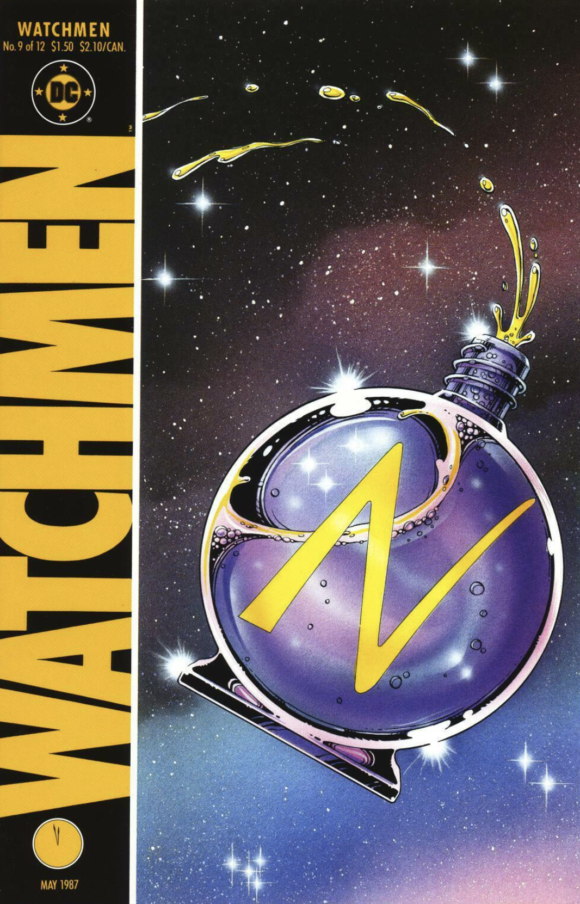
Laurie and Jon have a heart-to-heart on Mars, a funhouse mirror to Dr. Manhattan’s origin in #4, except this time Laurie’s salt-of-the-earth pragmatism is a welcome contrast to the Nuclear Dong’s calm predestination.
This is a terrific self-contained story, probably my favorite in the series, which is ostensibly the origin of my favorite character, Silk Spectre II. At the same time, however, it is a meditation on time, the meaning of life, the ever-mutating facets of human nature, and, you know. Typical capes-and-powers stuff.
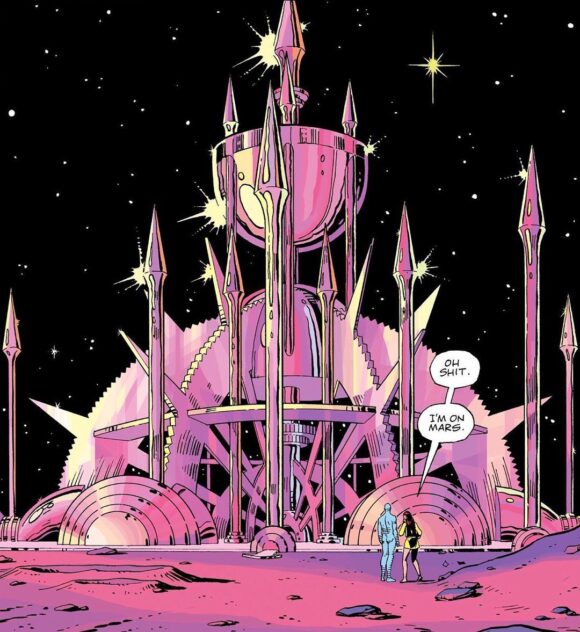
Dave Gibbons is the real star here, as the architecture-trained penciller creates some stunning images of Dr. Manhattan’s astrolabe-esque transport, not to mention the Martian landscape in all its beauty, along with nailing the acting of Jon and Laurie as the latter convinces the former, largely simply by being herself, that life on Earth is worth saving.
WINNER: WATCHMEN
—
I’m skipping a discussion of our #10s in the interest of space. Over in Earth-S, Nighthawk is gathering a group of unaffiliated super-beings to challenge the Squadron’s hegemony. On Earth-W, while Laurie and Jon are on Mars, Rorschach and Nite Owl II figure out Ozymandias is behind the so-called “Mask Killings,” in no small part because the World’s Smartest Man’s computer password is the Egyptian version of his own name. Ahem.
Squadron Supreme #11: “Betrayal”
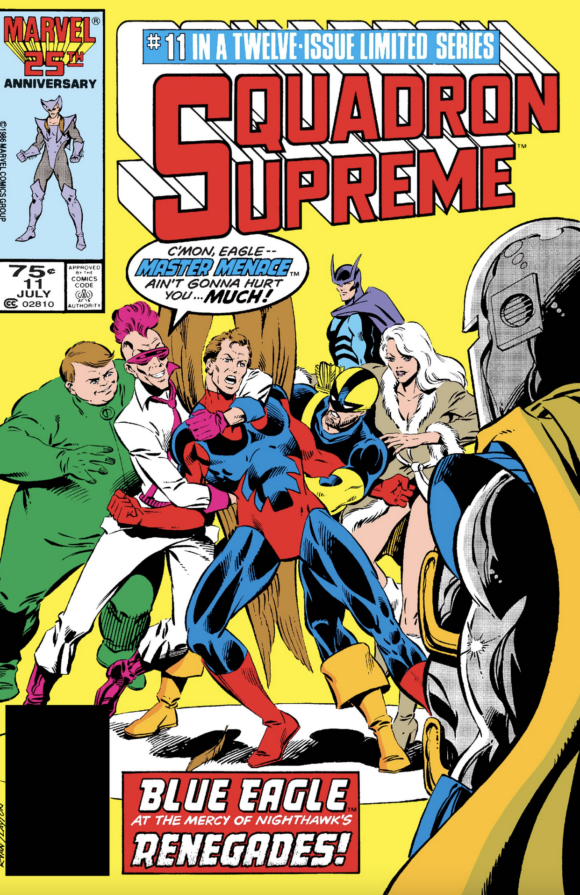
#Resistance leader Nighthawk now has five turncoats in the Squadron. Since none of them have criminal records, the B-Mod hasn’t been used on them—although, in a nice touch, the Squadroners debate, and ultimately decide against, using their brain-wipes to make sure they won’t turn against them. (A touch of Minority Report pre-crime, there.) As a practical matter, they’ll learn to regret that non-decision.
When one of the traitorous Squadroners steals the plans for the B-Mod devise, Ape-X (Gorilla Grodd, but female), catches her, but—surprise!—her brain modifications prevent her from ratting out a Squadron member, and the strain of doing so breaks her brain. It’s a great expression of the major theme of this series, i.e. the vast array of unintended consequences that come from super-people using their powers for something other than beating the crap out of each other.
—
Watchmen #11: “Look on My Works, Ye Mighty…”
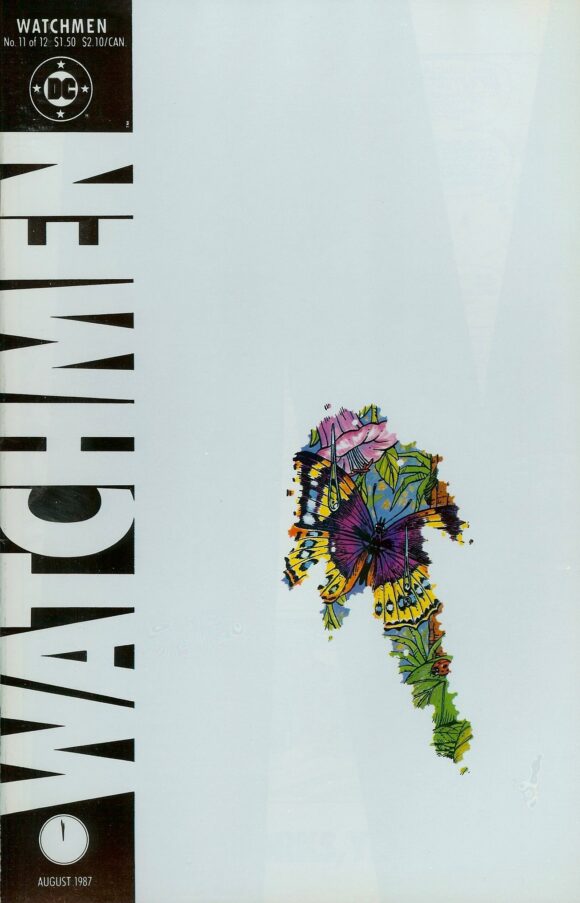
Ozymandias’s most famous line in the book, that he’s not some cheap monologuing supervillain and he actually executed his evil plan 35 minutes before Nite Owl II and Rorschach confronted him about it (I’ve always been amused by the echo of that line in the Breaking Bad episode “Ozymandias,” where Hank snipes at Walt that the Aryans made up their mind to kill him “ten minutes ago“), is ironically delivered after he has spent the entire issue running his mouth at the reader and the servants he’s murdered. (Did Moore read Veidt’s monologue out loud to himself to arrive at that 35-minute figure? I would have.) We also get “Black Freighter’s” turgid anti-climax, and a scuffle with some people-in-the-street characters no one has ever cared about.
This tidal wave of exposition, coming right before the big finish, has always been a big source of frustration to me as a reader. Get to the point already!
WINNER: SQUADRON SUPREME
—
Squadron Supreme #12: “The Dregs of Victory”
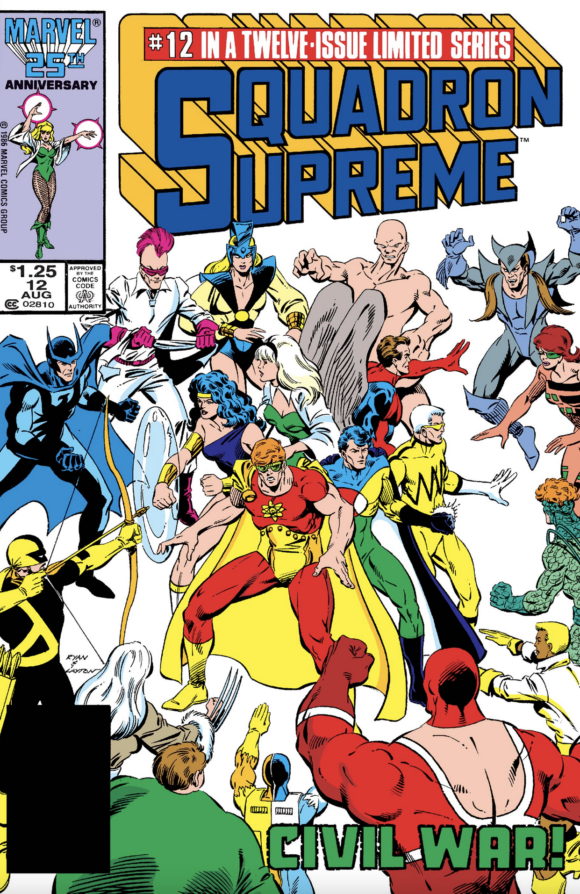
Ironically, only once the Squadron Supreme fulfills its utopian goals and returns power back to the civilian US government does Nighthawk attack them in their secret city. With his turncoats and unrevealed “Redeemers,” not to mention all the losses the Squadron has suffered throughout the series, Hyperion & Co. are outnumbered two-to-one. All sorts of subplots now come to the fore, like the fact that Zatanna (Arcana) has unwisely concealed her pregnancy from her teammates, leaving her rather vulnerable in the middle of a fight; and Foxfire (Vixen?), a de-brainwashed villain, isn’t entirely willing to give up on her hero career and boyfriend, Dr. Spectrum.
The ensuing battle royale is the stuff of a JLA fanatic like Mark Gruenwald’s dreams: Green Arrow (Golden Archer) blows up Green Lantern’s (Dr. Spectrum’s) ring with an arrow; he in turn gets a concave skull by Hawkman’s (Blue Eagle’s) mace. The Squadron is rather soundly beaten, but Foxfire kills Batman (Nighthawk) to avenge her boyfriend, only for herself to be killed by Catwoman (Mink). It’s a super-bloodbath!
—
Watchmen #12: “A Strong Loving World”
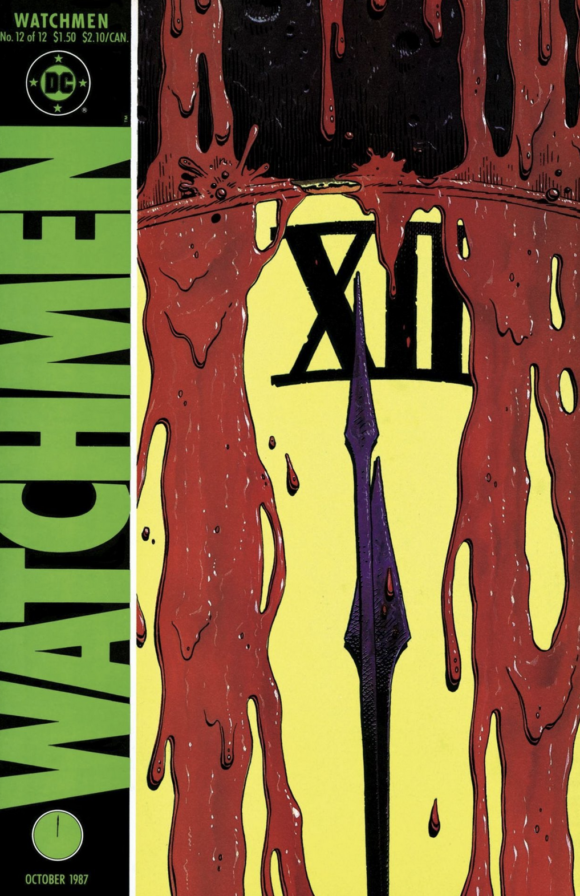
Did I say super-bloodbath?! The carnage of New York City, post-giant-alien-squid-teleportation, certainly has Squadron Supreme beat in that category. In the Marvel series, superheroes largely successfully create a post-Cold War utopia by trampling civil rights, only to abandon their accomplishments on being confronted, in a huge battle, with the human cost it took to achieve their aims.
In Watchmen, on the other hand, superheroes fail to prevent one of their own from creating a post-Cold War utopia through deceiving the public and mass murder, then after a brief fracas made all the more dramatic through Gibbons’ careful framing and pacing, decide, with one exception, to not bother telling anybody about it.
As a 2020 Tumblr cartoon amusingly puts it, both Veidt’s and the Squadron’s plans are astonishingly naive in the idea that society’s unrest could be pacified that easily by anybody in a cape, even if they were willing to kill half of the Big Apple to do it.
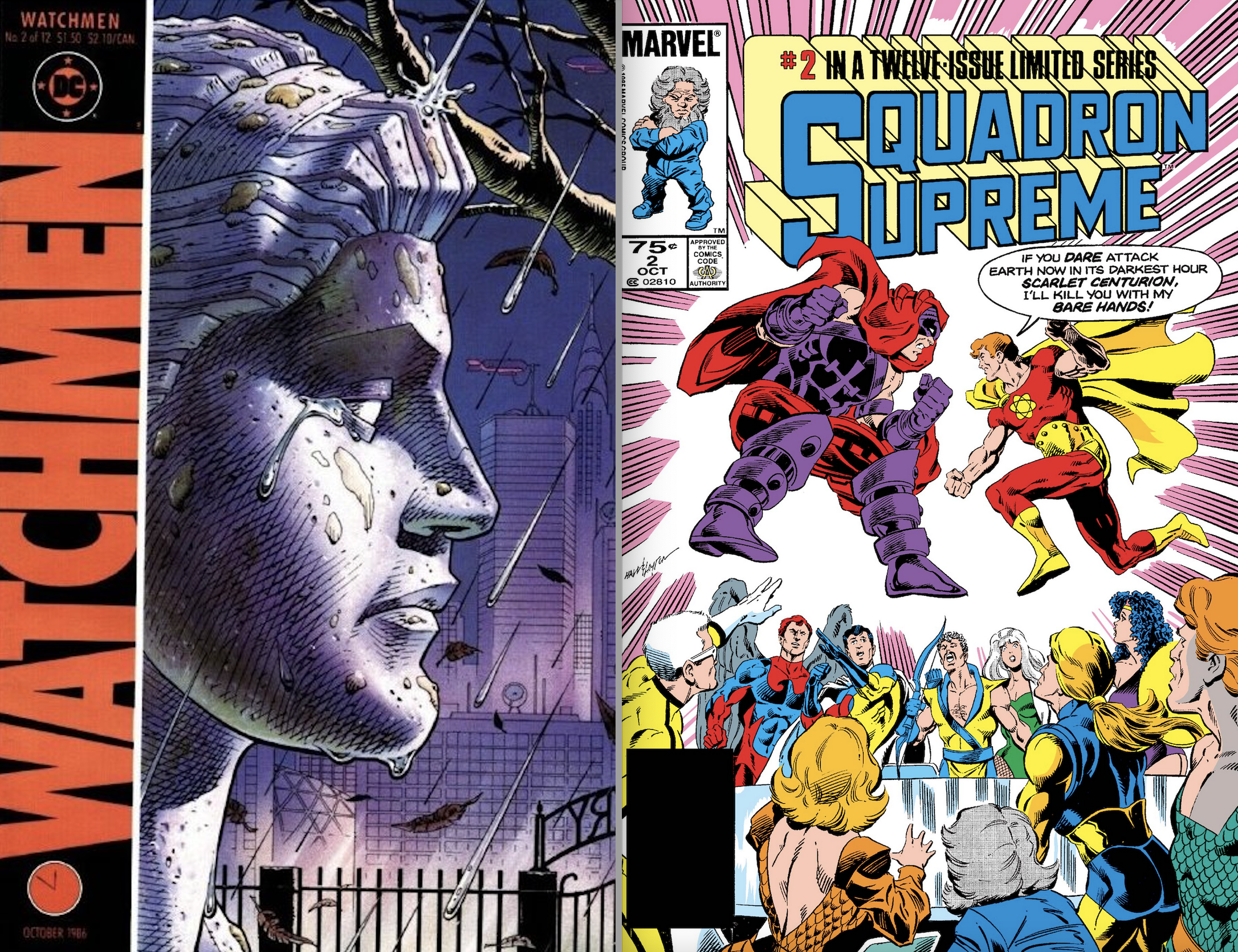
In the end, when judging these two books — however you might feel about the level of Moore and Gibbons’ skill versus Gruenwald and Ryan’s — where Watchmen absolutely has the better of Squadron Supreme is in the realm of characterization. Squadron Supreme has just too damn many heroes and villains for any to be explored in any great depth.
And the best thing about Watchmen is its characters, from the politely arrogant Veidt to the Regular-Jane Silk Spectre II to nutcase Rorschach to hesitant Nite Owl II to the cluelessly omnipotent Dr. Manhattan. Most of the actual “plot” of the book gets wrapped up in the first half of this issue and the rest of the action focuses on how the preceding events are processed by the main characters. Rorschach, of course, isn’t changed by them at all; until Dr. Manhattan changes him into a fine, red mist, that is.
It’s the strength of its heroes, not so much the well-thought-out world that surrounds them, or what they say about their genre, that makes Watchmen endure. And of course what happens when people love characters is that they won’t leave them the hell alone, inspiring prequel miniseries and HBO shows, whether Alan Moore approves or not. Ironically, it’s that love for his characters that makes the IP so exploitable. The book’s on-going success speaks for itself.
OVERALL WINNER: WATCHMEN

—
MORE
— COMIC BOOK DEATH MATCH: Swamp Thing vs. Man-Thing. Click here.
— The Complete COMIC BOOK DEATH MATCH Index. Click here.
—
13th Dimension contributor Fred Van Lente is a comics writer, historian and playwright.

February 20, 2022
This is like doing a death match between the Beatles and Herman’s Hermits. They’re both enjoyable in their own way, but one is an enduring classic and one is just fun.
February 20, 2022
I remember really enjoying the Squadron Supreme when it first came out and being very disappointed when Bob Hall left. I continued buying the whole series but kinda lost interest at that point. Never did find out why Bob Hall left but I wished he had stayed until the end.
February 20, 2022
Great comparison and a great read. It’s funny though as is the nature of comparisons much of it is subjective. While Watchmen benefitted from a consistent artist and a writer of Mr. Moore’s caliber to me Squadron Supreme was the series that resonated more with me. To me, Watchmen just felt too cold and detached and it just didn’t connect for me. To date his best/favorite work is still Miracleman and his Captain Britain work with Alan Davis. Thank you for this post. Brought ba k a lot of good memories.
February 21, 2022
Here, here.
February 20, 2022
Really interesting article. Must read them both again! Btw it was Sal not John Buscema that created the SS with Roy Thomas…
February 20, 2022
Corrected!
February 24, 2022
I thought Lie-perion did make an internal reference to sucking “Steve Trevor’s” final breath in issue 7. And in issue 8 he’s suddenly referred to as “unliving,” a clear reference to Bizarro (which also gets Hype off the hook for murder).
February 24, 2022
Oof, you are right, Brad, I re-hunted through #7 and finally found that. The reveal is done so strangely out of sequence I completely missed it.
February 26, 2022
This didn’t seem like a fair fight, but you did a great job giving the Squadron their due. I loved both series, but Watchmen was much more mind-blowing, in style, density, and subject matter. That being said, SS was the series I followed in real time when it came out, and it had me riveted. From #3 onward it was established there would be character deaths and status quo shifts all over the place, which was still a novelty in the mid-80s. And I guess I’m partial to the SS brawling bloodbath, with twists and shocks a-plenty, over the Watchmen multi-page spreads of bodies, which was shocking in a depressing way, fittingly enough.
Now that you’ve set the precedent for duelling maxi-series, might a Secret Wars vs. Crisis match-up be in the cards?
February 1, 2024
I remember! I dug “Squadron” for it’s colossal Earth-One_Earth Two riff and Watchmen was just a plain old classic! Thanks so much!